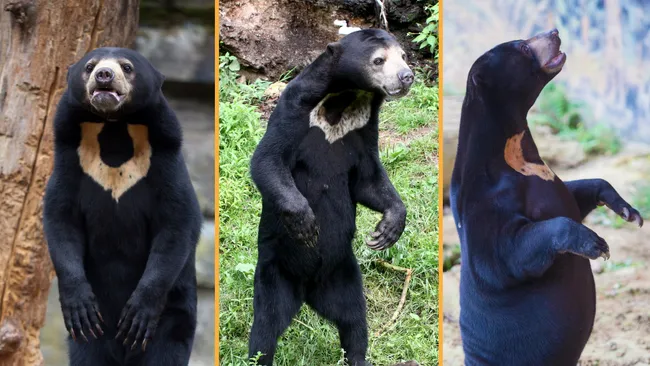Sun bears often stand upright like humans, and mothers even walk around cradling their babies in their arms.
Name: Sun bear (Helarctos malayanus)
Where it lives: Southeast Asia
What it eats: Ants, bees, beetles, honey, termites, fruit, plants, small mammals, and birds
Why it’s awesome: Sun bears frequently stand on their hind legs, appearing so similar to humans that they’ve been mistaken for people in costumes.
Sun bears are the smallest bears in the world. While grizzly bears (Ursus arctos horribilis) can weigh more than 700 pounds (320 kilograms), sun bears weigh between 60 and 150 pounds (30 to 70 kg) and are between 4 and 5 feet (1.2 to 1.5 meters) long. Found in Malaysia, China, Thailand, Laos, Cambodia, India, Bangladesh, and Myanmar, sun bears take their name from the golden or white patch on their chests, which resembles the rising sun. Although nicknamed “dog bears” because of their stocky build and short muzzles, these tree-dwelling mammals are best known for their human-like behavior. They often stand on their hind legs and have even been seen waving.
In the wild, standing frees up their front paws so they can reach for food such as fruit and dig into beehives and termite nests for honey and insects. They also have a 12-inch (30 centimeters) tongue — the longest tongue of any bear — to help them get their food.
Sun bears also stand to survey their surroundings and scare away other animals like tigers, displaying their colorful chest patch as a warning. Standing upright also helps them smell over longer distances.
Female sun bears, known as sows, have been observed walking on their hind legs while carrying their babies in their arms. This behavior may help them spot predators and safely move their offspring.
Recently, a captive sun bear named Angela became an internet sensation after she stood up and waved to visitors at Hangzhou Zoo in China. Her build, posture, and behavior seemed so human that people thought she was a performer in costume. The exact reason why these bears appear to wave is unknown, but it could be a form of communication. A study published in the journal Nature in 2019 found that captive sun bears are excellent communicators and can mimic each other’s facial expressions to build bonds, a behavior shared with humans. Biologists at Arizona State University and the University of Arizona suggest that sun bears’ evolved dexterity for tree climbing may enable them to wave simply because they can.
Sun bears are classified as vulnerable on the International Union for Conservation of Nature (IUCN) Red List of Threatened Species due to habitat loss and hunting. They are poached for bile from their gall bladders, used in traditional medicine, and for their paws, which are eaten.
